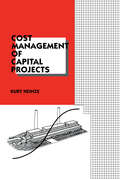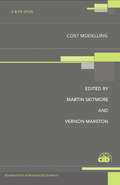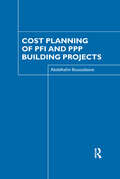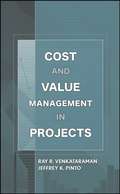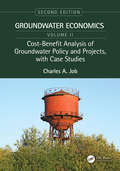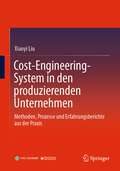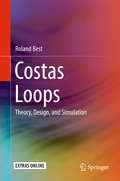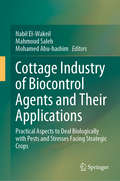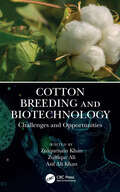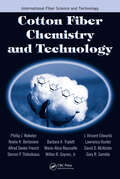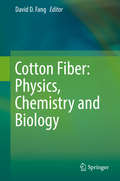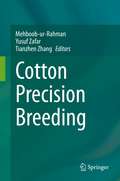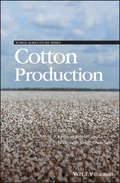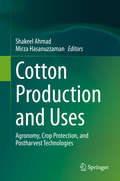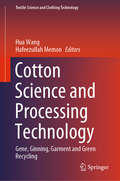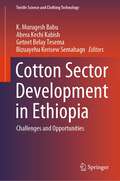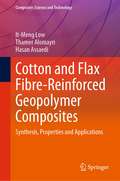- Table View
- List View
Cost Management of Capital Projects (Cost Engineering #27)
by Kurt HeinzeAiming to bridge the gap between the quantitative viewpoint of management science and the practical, day-to-day needs of project cost management, this text offers coverage of an integrated cost management programme. It presents the use of method study techniques to increase the effectiveness of procedures and improve the productivity of resources, emphasizing a systematic approach to cost control.
Cost Management of Construction Projects
by Donald ToweyThe cost manager/quantity surveyor plays a pivotal role in the financial and contract management of construction projects, although the exact nature of the service they provide depends on the project employer's terms of engagement. This can mean acting as consultant in a range of roles including cost and advisory services for budget setting to initiate a project, cost management through the design and construction phases, contract administration and acting as the client side project manager to oversee the entire building process.Cost Management of Construction Projects focusses on the cost manager/quantity surveyor engaged by the project client, and discusses key elements that help drive project success including measurement (based on the New Rules of Measurement published by RICS), procurement, cost planning, contract administration and project cost management. With examples, it provides a thorough guide to the role in the workplace and in the field, directly addressing the day to day situations faced by the cost manager/quantity surveyor.Donald Towey MRICS has extensive experience of the construction industry. His experience began as an estimator with a glass/glazing contractor in Manchester. Following a number of positions with UK contractors he relocated to Australia and has worked with a number of developers and main contractors, as well as doing freelance work. He is currently working in contracts management in Sydney.
Cost Modelling
by Martin Skitmore Vernon MarstonCost models underlie all the techniques used in construction cost and price forecasting, yet until relatively recently industry has been unfamiliar with their characteristics and properties. An understanding of the various types of cost model is vital to enable effective cost control and the development of future forecasting techniques.This volume brings together more than 20 seminal contributions to building cost modelling and introduces the major landmarks in progress and thinking in this field:* strategies and directions* explorations in cost modelling* cost-product/process modelling* dealing with uncertaintyThe strong techniques bias of this book will appeal to construction professionals involved in estimating, as well as researchers and students of building economics.
Cost Optimal and Nearly Zero-Energy Buildings: Definitions, Calculation Principles and Case Studies (Green Energy and Technology)
by Jarek KurnitskiCost optimal and nearly zero energy performance levels are principles initiated by the European Union's (EU) Energy Performance of Buildings Directive which was recast in 2010. These will be major drivers in the construction sector in the next few years, because all new buildings in the EU from 2021 onwards are expected to be nearly zero energy buildings (nZEB). This book introduces the technical definitions, system boundaries, energy calculation methodology and input data needed to set primary energy based minimum/cost optimal and nZEB requirements in national energy frames. Worked examples are provided to illustrate the calculation of delivered, exported and primary energy, and renewable energy contribution. Five case studies of high performance nZEB office buildings across Europe are reported to show alternative technical solutions and to draw some general design rules based on completed nZEB buildings. Specific features of the nZEB design process, especially in the early stages, and architectural competitions are included. These describe important design issues in the scoping and conceptual design phase, allowing design streams to be controlled so that specified targets can be met. This book is intended for readers who need to be aware of or are working with the energy performance of buildings - for decision makers in public and private sectors, architects, engineers, construction clients, consultants, contractors, manufacturers and students. The editor of this book, Professor Jarek Kurnitski has made major contributions to the preparation of the European REHVA nZEB technical definition and has developed energy calculation frames for current Estonian and Finnish energy performance regulations. He is the leader of nZEB research at Tallinn University of Technology in Estonia and Aalto University in Finland, and he has over 300 publications.
Cost Planning of PFI and PPP Building Projects
by Abdelhalim BoussabaineThis topical and timely book presents and innovative approach to dealing with the complexities of cost planning in PFI. PFI/PPP projects have a significantly different costing environment from conventionally procured projects, requiring cost analysts to use their expertise and innovative thinking to develop whole-life cost solutions that deliver value for money to the client, thus improving public building assets performance. Abdelhalim Boussabaine provides a thorough grounding in the theory of PFI, from its early evolution through to examples of current projects. In particular, the rationale for private financing of public services, arguments for and against PFI and 'value for money' mechanisms are discussed. The book presents an innovative framework for whole-life value and calls for changes in the way whole life cycle value is perceived, created and exchanged. Cost Planning of PFI and PPP Building Projects provides the reader with existing knowledge as well as present innovative thinking for future development and management of PFI/PPP cost planning processes. Given the importance and novelty of this book, academics, professionals, undergraduate and postgraduate students will find this book valuable.
Cost Studies of Buildings
by Srinath Perera Allan AshworthThis practical guide to cost studies of buildings has been updated and revised throughout for the 6th edition. New developments in RICS New Rules of Measurement (NRM) are incorporated throughout the book, in addition to new material on e-business, the internet, social media, building information modelling, sustainability, building resilience and carbon estimating. This trusted and easy to use guide to the cost management role: Focuses on the importance of costs of constructing projects during the different phases of the construction process Features learning outcomes and self-assessment questions for each chapter Addresses the requirements of international readers From introductory data on the construction industry and the history of construction economics, to recommended methods for cost analysis and post-contract cost control, Cost Studies of Buildings is an ideal companion for anyone learning about cost management.
Cost and Value Management in Projects
by Jeffrey K. Pinto Ray R. VenkataramanCost and Value Management in Projects provides practicing managers with a thorough understanding of the various dimensions of cost and value in projects, along with the factors that impact them, and the managerial approaches that would be most effective for achieving cost efficiency and value optimization. This book addresses cost from a strategic perspective, offering thorough coverage of the various elements of value management such as value planning, value engineering and value analysis from the perspective of projects.
Cost-Benefit Analysis of Groundwater Policy and Projects, with Case Studies: Groundwater Economics, Volume 2
by Charles A. JobThe competition for groundwater sources as a water supply reinforces the need for a strong economic rationale in decision-making. Evaluating economic decisions in the context of total water management and life-cycle water use is essential to making critical development and remediation choices. This revised volume provides fundamental economic and policy concepts related to groundwater, discusses important factors in life-cycle cost-benefit evaluation and explains triple-bottom-line analysis for different groundwater projects. It includes new and updated case studies on groundwater issues with solutions for a range of situations based on economic data. FEATURES OF THIS VOLUME Provides an understanding for the fundamental economic approaches to groundwater policy and project evaluation Incorporates life-cycle cost-benefit approaches in a triple-bottom-line framework Includes new case studies on the economics of health protection, managed aquifer recharge, local versus regional supply and strategic life-cycle analysis Addresses local and regional groundwater economic choices through a series of practical applications Explores transboundary, international, climate change and macroeconomic factors influencing groundwater project and program decisions Cost-Benefit Analysis of Groundwater Policy and Projects, with Case Studies, Second Edition, the second volume of the two-volume set Groundwater Economics, is a must-have for any professional or student who needs to understand and evaluate water resources and manage their use from a variety of sustainable approaches.
Cost-Effectiveness Analysis: A Systems Engineering Perspective
by Howard EisnerThis book provides an overview of cost-effectiveness analysis, which is a well-known and intuitive method for defining and choosing among a set of alternatives. This book relates cost-effectiveness analysis to systems engineering to solve everyday problems at home and the office. It can also be used in technical processes, system design, and project management. Cost-Effectiveness Analysis: A Systems Engineering Perspective starts with providing an overview and background of cost-effectiveness analysis and how it’s used. It then goes on to discuss cost-effectiveness concerning systems engineering and links its use to resolving military issues and problems. The book comes to an end with exploring the usage related to systems architecting, re-engineering office systems, and comparing its use to everyday life decision-making scenarios. Targeted market includes general engineers, systems engineers, process engineers, project management, scientists, technologists, mathematicians, and lawyers.
Cost-Engineering-System in den produzierenden Unternehmen: Methoden, Prozesse und Erfahrungsberichte aus der Praxis
by Xiaoyi LiuFunktion, Qualität und Kosten sind die drei Kernelemente eines Produkts. Vor allem in der Zukunft, unter dem allgemeinen Trend der Digitalisierung und AI, ist es für produzierende Unternehmen ein Muss, ein vollständiges Cost-Engineering-System zu etablieren.Basierend auf 25 Jahren praktischer Erfahrung und Methodenforschung in deutschen und chinesischen Automobilunternehmen stellt der Autor in diesem Buch zum ersten Mal Cost- Engineering-System, Cost-Engineering-Methoden und deren praktische Anwendungen im gesamten Produktprozess systematisch vor, und präsentiert eine große Anzahl von Beispielen der Kostenoptimierung aus Praxis. Blickt man in die Zukunft, wie der Qualitätssystemstandard benötigt auch das Cost-Engineering- System einen Standard für Produktionsunternehmen. Kostenanalysesoftware, AI + Cost Engineering sind wichtige Mitteln für produzierende Unternehmen, um das Potenzial der Kostenoptimierung im vollen Umfang und in intelligenter Weise auszuschöpfen.
Costas Loops: Theory, Design, and Simulation
by Roland BestThis book guides engineers through the use of the Costas loop, which can be considered an extension of the better known Phase-locked loop. The author discusses all three variants of the Costas loop and describes their dynamic behavior, using newly developed mathematical models. Step-by-step design procedures and Simulink models are included for every type of Costas loop. These models enable designers to test circuits prior to building breadboards or prototypes, accelerating the design process considerably.
Cottage Industry of Biocontrol Agents and Their Applications: Practical Aspects to Deal Biologically with Pests and Stresses Facing Strategic Crops
by Mohamed Abu-Hashim Nabil El-Wakeil Mahmoud SalehThis book analyses the mass production and application of biological control products for biotic and abiotic factors affecting agricultural production. It also describes how to develop sustainable agriculture under Egyptian conditions. The book is divided into four parts covering: 1) mass production of parasitoids, insects and mite predators, 2) mass production of the microbial control agents for managing insect pests, 3) biocontrol products for plant diseases, and 4) bioproducts against abiotic factors. It discusses various methods of controlling insect pests and plant diseases in order to increase agricultural production, improve the quality of field crops and reduce the food gap by applying a range of technologies. This book helps increase our understanding and awareness of how to produce healthy products for local consumption and utilization as well as for exports.
Cotton
by Stephen YafaIn the tradition of Mark Kurlansky's Cod and Salt, this endlessly revealing book reminds us that the fiber we think of as ordinary is the world's most powerful cash crop, and that it has shaped the destiny of nations. Ranging from its domestication 5,500 years ago to its influence in creating Calvin Klein's empire and the Gap, Stephen Yafa's Cotton gives us an intimate look at the plant that fooled Columbus into thinking he'd reached India, that helped start the Industrial Revolution as well as the American Civil War, and that made at least one bug—the boll weevil—world famous. A sweeping chronicle of ingenuity, greed, conflict, and opportunism, Cotton offers "a barrage of fascinating information" (Los Angeles Times). .
Cotton Breeding and Biotechnology: Challenges and Opportunities
by Zulfiqar Ali Zulqurnain Khan Asif Ali KhanCotton Breeding and Biotechnology presents information on one of the most economically important crops of the world, cotton. This book contains chapters on the history of cotton; breeding approaches; technologies for increasing germination, crop growth and yield; and fiber quality issues. It emphasizes sustainable development in the cotton industry analysing the progress of breeding technologies under environmental adversity. The book explores the national and global status of cotton crop, including cotton production, possible impacts of climate change, and the vulnerability of cotton to pest infestations and disease attacks. Features Focuses on cotton breeding and biotechnology Proposes ideas, data, and strategies to mount breeding programs for enhancing cotton production Details strategies for cotton quality improvement against abiotic and biotic stresses Emphasizes the revival of cotton in Pakistan and South Asian region This book is useful to researchers, cotton breeders and growers, farmers, and the agriculture industry.
Cotton Fiber Chemistry and Technology
by Phillip J. Wakelyn Noelie R. Bertoniere Alfred D. French Devron P. Thibodeaux Barbara A. Triplett Marie-Alice Rousselle Wilton R. Goynes Jr. J. Vincent Edwards Lawrance Hunter David D. McAlister Gary R. GambleAnnual cotton production exceeds 25 million metric tons and accounts for more than 40 percent of the textile fiber consumed worldwide. A key textile fiber for over 5000 years, this complex carbohydrate is also one of the leading crops to benefit from genetic engineering. Cotton Fiber Chemistry and Technology offers a modern examination of co
Cotton Fiber: Physics, Chemistry and Biology
by David D. FangCotton fiber is the most important natural fiber used in the textile industry. The physical structure and chemical compositions of cotton fibers have been extensively studied. Newer high speed spinning instruments are being deployed around the world that demand longer, stronger and finer fibers. Consequently, genetic improvement in fiber quality has been stressed. With improvement in fiber quality has come the realization that further fiber improvement will require a better understanding of fiber development and biology. As a consequence, cotton fiber developmental biology, genetics and genomics have become focal points in the cotton research community. As the longest single-celled plant hair, cotton fiber has been used as an experiment model to study trichome initiation and elongation in plants. This book provides a comprehensive update on cotton fiber physics, chemistry and biology that form the three sections of the book. In the physics section, the physical structure of cotton fiber is first illustrated in great detail. Then a suite of fiber properties and their measuring methods are described. The pros and cons of each method are outlined. New methods to measure physical properties of single fiber and young developing fibers are included. In the chemistry section, the chemical compositions of cotton fibers are described in detail. This knowledge is necessary for efficient modification of cotton fibers for better and broader utilization. The advancement in cotton fiber modification using chemical and enzymatic methods opened new ways to utilize cotton fibers. In the biology section, the book first introduces the utilization of naturally occurring color cottons. Color cottons possess unique attributes such as better fire retardant ability. Advancement in understanding fiber color genetics and biochemical pathways and new utilization of color cottons are discussed. Recent technological advancements in molecular biology and genomics have enabled us to study fiber development in great depth. Many genes and quantitative trait loci related to fiber quality attributes have been identified and genetically mapped. Some of these genes and QTLs are being used in breeding. Progresses in cotton fiber improvement using breeding and biotechnology are discussed in the last chapter. This book serves as a reference for researchers, students, processors, and regulators who either conduct research in cotton fiber improvement or utilize cotton fibers.
Cotton Fibers: Developmental Biology, Quality Improvement, and Textile Processing
by Amarjit S. BasraExplore new and proven information about cotton fibers!Cotton Fibers is an important reference source for anyone who produces, markets, and researches cotton fibers. This unique book is written by internationally renowned researchers who have pooled their immense knowledge to create this outstanding volume that deals with development, quality improvement, and textile/technological aspects of cotton production. Cotton, a worldwide crop that is valued at $20 billion, is the premiere natural fiber for textiles. As cotton fiber consumption continues to increase, the crop is becoming a major importance to the economies of both developed and developing countries. Cotton Fibers covers the recent explosion of information on cotton fibers and points out research priorities for the future, consequently stimulating multidisciplinary cotton research. Cotton Fibers provides you with information on topics that will help you improve the quantity and quality of cotton crops, such as: developing cotton fibers in vitro developing cellulose biosynthesis in cotton fibers modifying cotton fibers with genetic engineering strategies managing postharvest fiber quality abating air pollution and disposal of gin waste fiber-to-fabric engineering for optimal cotton fiber quality structural development of cotton fibers and linkages to fiber quality cotton germplasam resources and their potential for improved fiber productivity and quality molecular genetics of developing cotton fibersComplete with charts and diagrams, Cotton Fibers is a thorough exploration of what is known about cotton fibers and what research is just beginning to reveal about the crop. You will explore some of the latest technological advances in cotton fiber production, such as understanding the genetics of fiber growth and development and introducing hormone genes into cotton. This comprehensive guide is a vital tool for anyone interested in increasing the yield and quality of cotton, the world's most popular fiber.
Cotton Precision Breeding
by Mehboob-Ur-Rahman Yusuf Zafar Tianzhen ZhangCotton, the most important natural fiber crop, has been improved by conventional breeding—largely through planned hybridization of different cotton genotypes, since the discovery of Mendelian genetics. All these efforts resulted in the development of resilient high yielding cotton varieties. However, the progress through conventional breeding procedures is slow because of long lag periods for developing a variety, little control over the new genetic combinations, unwanted traits and lack of foolproof performance testing system. Genomic assays discovered over the last two decades have made it possible to understand the “language” of the genome by associating the genes with specific traits. Together with the more recently established gene-editing tools like CRISPR-Cas9, the cotton genome can be tailored much more precisely than ever before. In this regard, genetic information has been harnessed, through (i) sequencing of the progenitor and cultivated cotton species, (ii) ongoing mega pan-genome sequencing projects, (iii) genetic and physical mapping, and (iv) introgression of genes from alien sources, that resulted in the development of resilient cotton cultivars. These technologies have been deployed or are attempting to overcome the challenges of water shortage, excessive heat in most cotton growing regions, infectious diseases and infestation of insect pests, as well as rising production cost, for sustainable cotton production beyond 2030. In this book, new knowledge generated by the cotton research community and its application for developing resilient cotton are comprehensively summarized. This book contributed by well-known cotton researchers is a timely collection of the challenges and successes of precision cotton breeding in a changing environment.
Cotton Production (World Agriculture Series)
by Khawar Jabran Bhagirath Singh ChauhanProvides a comprehensive overview of the role of cotton in the economy and cotton production around the world This book offers a complete look at the world’s largest fiber crop: cotton. It examines its effect on the global economy—its uses and products, harvesting and processing, as well as the major challenges and their solutions, recent trends, and modern technologies involved in worldwide production of cotton. Cotton Production presents recent developments achieved by major cotton producing regions around the world, including China, India, USA, Pakistan, Turkey and Europe, South America, Central Asia, and Australia. In addition to origin and history, it discusses the recent advances in management practices, as well as the agronomic challenges and the solutions in the major cotton producing areas of the world. Keeping a focus on global context, the book provides sufficient details regarding the management of cotton crops. These details are not limited to the choice of cultivar, soil management, fertilizer and water management, pest control, cotton harvesting, and processing. The first book to cover all aspects of cotton production in a global context Details the role of cotton in the economy, the uses and products of cotton, and its harvesting and processing Discusses the current state of cotton management practices and issues within and around the world’s cotton producing areas Provides insight into the ways to improve cotton productivity in order to keep pace with the growing needs of an increasing population Cotton Production is an essential book for students taking courses in agronomy and cropping systems as well as a reference for agricultural advisors, extension specialists, and professionals throughout the industry.
Cotton Production and Uses: Agronomy, Crop Protection, and Postharvest Technologies
by Mirza Hasanuzzaman Shakeel AhmadThis book provides a comprehensive and systematic overview of the recent developments in cotton production and processing, including a number of genetic approaches, such as GM cotton for pest resistance, which have been hotly debated in recent decades. In the era of climate change, cotton is facing diverse abiotic stresses such as salinity, drought, toxic metals and environmental pollutants. As such, scientists are developing stress-tolerant cultivars using agronomic, genetic and molecular approaches. Gathering papers on these developments, this timely book is a valuable resource for a wide audience, including plant scientists, agronomists, soil scientists, botanists, environmental scientists and extention workers.
Cotton Science and Processing Technology: Gene, Ginning, Garment and Green Recycling (Textile Science and Clothing Technology)
by Hua Wang Hafeezullah MemonThis book summarizes all different fields of cotton fiber, including genetics, fiber chemistry, soft materials, textile, and fashion engineering. It also contains some new applications such as biomaterials, nanocoated smart fabrics, and functional textiles. Moreover, the significant improvement recently in gene modification and gene technology is introduced. This book discusses all these aspects in a more straightforward way, and new illustrations will help readers to understand the contents. It is intended for undergraduate and graduate students who are interested in cotton science and processing technologies, researchers investigating the updated applications of cotton in various fields as well as industrialists who want to have a quick review of the cotton and its different stages.
Cotton Sector Development in Ethiopia: Challenges and Opportunities (Textile Science and Clothing Technology)
by Abera Kechi Kabish K. Murugesh Babu Getnet Belay Tesema Bizuayehu Kerisew SemahagnThis book highlights the development of cotton sector and its related issues, in Ethiopia. The book is a comprehensive collection of detailed chapters ranging from agricultural aspects of cotton, its value chain, and economics. It provides an overview of the cotton sector development and the challenges faced in the growth and extension of cotton production and research in three separate sections i.e., cotton agriculture, cotton fibre technology and cross-cutting issues in the cotton sector. In the first part of the book, agricultural aspects of cotton fibre production such as, cotton agronomy, genetics and breeding, biotechnology, mechanized production, crop harvesting management are discussed in detail. This is followed by chapters concerned to a comprehensive knowledge on cotton fibre demand and supply in Ethiopia, ginning technology and industries, cotton quality testing and grading, quality requirements for spinning, cotton fabric production, chemical processing aspects and therole of cotton fabrics in the Ethiopian fashion industry. The final section of the book deals with chapters on the cotton seed production techniques, cotton research and promotion, challenges in quality cotton production, cotton value chain and economics and sustainable cotton production. This book is a valuable resource for all those concerned with cotton biology and agriculture, production and extension, research and development, fashion industry, research and academia.
Cotton and Flax Fibre-Reinforced Geopolymer Composites: Synthesis, Properties and Applications (Composites Science and Technology)
by It-Meng Low Thamer Alomayri Hasan AssaediThis book provides an overview on the latest advances in the synthesis, properties and applications of geopolymers reinforced with natural fibres such as pulp fibre, cotton, sisal, flax and hemp. The influence of adding various natural fibres and nanofillers on the mechanical properties of these composites is discussed. Potential challenges and future directions of these composites are highlighted and addressed. The content of this book caters to students, researchers and academics who are interested in the synthesis and applications of geopolymers composites.
Cotton, Water, Salts and Soums: Economic and Ecological Restructuring in Khorezm, Uzbekistan
by Inna Rudenko P.L.G. Vlek John P.A. Lamers Christopher MartiusThis book summarizes a long-term research project addressing land and water use in the irrigated areas of the Aral Sea basin. In an interdisciplinary approach, natural and human sciences are combined to elucidate the challenges of economic transition that affect the use of land, water and biological resources, ecological sustainability, economic efficiency and the livelihoods of the local population. The research focuses on Khorezm, a region in Uzbekistan, located on the Amudarya river, in the heart of Central Asia. A series of chapters describes the biophysical environment and the aspects of society and institutions that shape land and water use. The book discusses options and tools to improve land and water management, and to reform the economic system management, based on agronomic, hydrological, economic ans social studies and modeling. The insights are not only important for Uzbekistan, but for all countries in transitions and irrigated dryland areas elsewhere.
Cotton: The Biography of a Revolutionary Fiber
by Stephen YafaIn the tradition of Mark Kurlansky's Cod and Salt, this endlessly revealing book reminds us that the fiber we think of as ordinary is the world's most powerful cash crop, and that it has shaped the destiny of nations. Ranging from its domestication 5,500 years ago to its influence in creating Calvin Klein's empire and the Gap, Stephen Yafa's Cotton gives us an intimate look at the plant that fooled Columbus into thinking he'd reached India, that helped start the Industrial Revolution as well as the American Civil War, and that made at least one bug--the boll weevil--world famous. A sweeping chronicle of ingenuity, greed, conflict, and opportunism, Cotton offers "a barrage of fascinating information" (Los Angeles Times).
